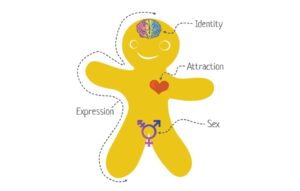In a world that often seems insistent on sorting people into boxes marked ‘male’ or ‘female’, it’s important to remember that gender is a fluid and diverse concept that can’t be easily confined within the limitations of societal norms. Many individuals identify outside of the binary gender system. And prefer to be referred to as ‘non-binary’. This blog post will shed light on what it means to be non-binary, the struggles these individuals face, and how we can support and affirm them in their unique identities.
Contents
Defining Non-Binary People
 Non-binary is a term that encompasses a range of gender identities that do not exclusively align with the traditional notions of ‘male’ or ‘female’. Instead, it’s a term used by individuals who might identify as having no gender. And being gender-fluid, falling somewhere in between male and female, or having a gender identity that is complex and unique to them.
Non-binary is a term that encompasses a range of gender identities that do not exclusively align with the traditional notions of ‘male’ or ‘female’. Instead, it’s a term used by individuals who might identify as having no gender. And being gender-fluid, falling somewhere in between male and female, or having a gender identity that is complex and unique to them.
Non-binary is an umbrella term that is often used interchangeably with other terms like genderqueer, gender non-conforming, and gender diverse. Although each of these labels can carry its own unique connotations and individual interpretations.
It’s important to understand that being non-binary is about self-identification and self-expression. Each non-binary person’s experience is unique and might not necessarily fit into a neatly defined category. Non-binary people may express their gender in varied ways. And might not necessarily choose to present as androgynous or as a blend of male and female.
How To Know If I’m Non-Binary?
Gender identity is a deeply personal and individual matter, and only you can determine if you identify as non-binary. The process of understanding your own gender identity can involve introspection, self-questioning, and exploration.
Here are some thoughts and feelings that might guide you toward realizing you might be non-binary:
- You Don’t Feel Fully Aligned with ‘Male’ or ‘Female’
If you often feel uncomfortable, or like you don’t quite fit into the categories of ‘male’ or ‘female’. Then, this could indicate that you might identify outside the gender binary.
- Dissatisfaction with Gender Norms
You might feel discomfort or distress with societal expectations, roles, or norms associated with your assigned gender at birth. This discomfort could manifest in different ways such as disliking your body or feeling ill at ease when grouped with people of your assigned gender. Or feeling misunderstood when people refer to you by gendered pronouns that don’t match your identity.
- Gender Fluidity
You might identify as different genders at different times. Some days you might feel more feminine, other days more masculine, and other times neither or both.
- Identifying with Other Non-Binary Individuals
You might feel a sense of understanding or shared experience when listening to or reading about the experiences of other non-binary individuals.
- The Desire for Another Term
You might feel more comfortable with terms such as ‘genderqueer’, ‘genderfluid’, ‘agender’, ‘bigender’, ‘neutrons’, and so on. Rather than ‘male’ or ‘female’.
If you’re questioning your gender identity, consider seeking out resources and support. Remember that figuring out your gender identity is not a race — take the time you need to understand yourself.
How Is Gender Identity Different From Gender Expression?
 Gender identity and gender expression are distinct but interconnected aspects of a person’s overall gender experience.
Gender identity and gender expression are distinct but interconnected aspects of a person’s overall gender experience.
Gender Identity refers to an individual’s deep-seated, internal sense of their own gender. This may be male, female, a blend of both, neither, or something entirely different. Your gender identity is about how you perceive yourself and how you internally make sense of your own gender. It is not necessarily tied to your physical characteristics or biological sex, and only you can define your gender identity.
On the other hand, Gender Expression refers to the external presentation of one’s gender identity. That may be expressed through clothing, hairstyle, behavior, voice, body characteristics, etc. This is how individuals choose to present and communicate their gender to others in society.
While gender expression often aligns with an individual’s gender identity, this is not always the case. For example, a person may identify as female (gender identity). But present in a way that society deems masculine (gender expression).
What Are The Challenges Faced by Non-Binary People?
Non-binary individuals often face a multitude of challenges due to societal norms and expectations about gender. It’s important to remember that these challenges vary significantly based on geographical location, cultural context, and individual experiences. Here are a few common issues that non-binary people often face:
1. Misunderstanding and Lack of Acceptance
Many people aren’t familiar with non-binary identities or don’t understand what it means to be non-binary. This lack of understanding can lead to the dismissal of non-binary identities, belittlement, and invalidation of their experiences.
2. Discrimination and Harassment
Non-binary individuals often face discrimination and harassment in various aspects of life, including education, employment, healthcare, and housing. They may also encounter bullying, physical violence, or hate crimes.
3. Legal Challenges
Many countries don’t legally recognize non-binary genders. That can lead to problems with identification documents, legal proceedings, and rights protection.
4. Mental Health Issues
Non-binary people often face increased rates of mental health issues, including anxiety, depression, and suicidal thoughts and behaviors. This is largely due to societal stigma, discrimination, and lack of acceptance.
5. Healthcare Access
In healthcare, non-binary individuals often face prejudice, lack of understanding, and even refusal of care. Additionally, they might encounter difficulties accessing gender-affirming treatments and surgeries.
6. Pronoun Misuse and Deadnaming
Non-binary individuals often have to deal with others using incorrect pronouns (pronoun misgendering) or their old names (known as deadnaming). Eventually, it can cause significant distress.
7. Lack of Representation
There is a lack of non-binary representation in media, politics, and various other social arenas. That can perpetuate misunderstanding and stigma, and make non-binary individuals feel invisible or unvalued.
Thus, while non-binary individuals face significant hurdles, understanding these challenges is the first step toward change. It’s crucial to remember that everyone’s identity deserves respect and recognition, and non-binary people are no exception.
How People Can Support These People?
 Supporting non-binary individuals involves fostering understanding, practicing respect, and advocating for their rights. Here are a few concrete ways to show your support:
Supporting non-binary individuals involves fostering understanding, practicing respect, and advocating for their rights. Here are a few concrete ways to show your support:
1. Educate Yourself and Others
Learn about non-binary identities, gender spectrums, and the issues non-binary people face. Share this knowledge with your friends, family, and colleagues to help foster a more inclusive understanding of gender.
2. Use Correct Pronouns and Names
Always use the pronouns and names that a person has requested you to use. If you’re unsure, it’s perfectly okay to politely ask. Remember, using correct pronouns is a matter of respect.
3. Support Non-Binary Representation
Encourage and support a representation of non-binary people in media, workplaces, and other social arenas. This can be done by supporting non-binary artists, writers, businesses, etc., and advocating for diversity and inclusion initiatives.
4. Challenge Binary Norms
Speak up against systems and practices that force people into a gender binary. This might be as simple as questioning why a form only offers ‘male’ and ‘female’ options, or advocating for gender-neutral restrooms.
5. Be an Ally
Stand up for non-binary people when you witness discrimination or harassment. Advocacy can range from correcting someone who uses incorrect pronouns, to lobbying for policy changes that protect non-binary rights.
6. Support Mental Health
Acknowledge the mental health issues that can be prevalent within the non-binary community due to societal pressures and discrimination. Offer emotional support to your non-binary friends, and advocate for better mental health resources for non-binary individuals.
7. Listen and Validate
Every non-binary person’s experience is unique. Listen to their stories, validate their experiences, and be open to learning from them.
Remember, being an ally is an ongoing process of learning, listening, and acting in solidarity. It’s about using your privilege to uplift the voices and rights of those who face marginalization.
Conclusion
In conclusion, understanding and acknowledging the experiences of non-binary people is an essential step toward a more inclusive and respectful society. With an estimated quarter of the youth identifying as non-binary, it’s clear that the traditional binary perspective on gender is no longer representative of the diverse identities that exist in our world.
Let us remember that being an ally to non-binary people extends beyond theoretical understanding. It involves active efforts – from correctly using preferred pronouns, challenging binary norms, and standing up against discrimination, to advocating for non-binary rights.
Life may sometimes be challenging for people from the LGBTQ community, but Online LGBTQ Counseling can help. Get experienced LGBTQ therapists at PrideMantra: Book a trial LGBTQ therapy session


